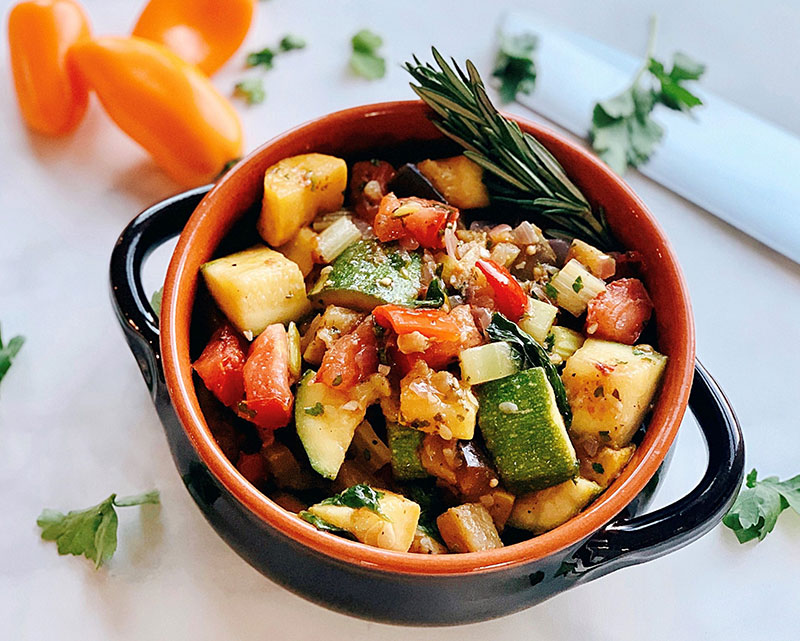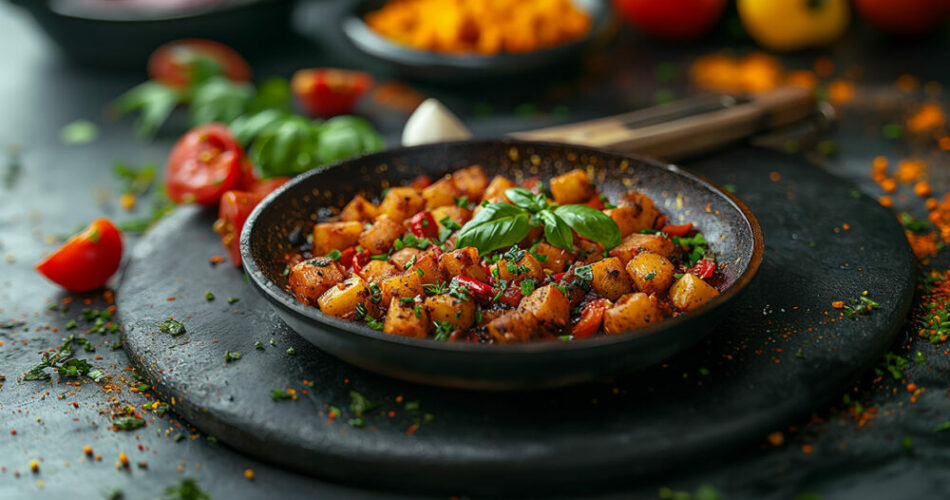Imagine the heart of French cuisine, nestled in your kitchen, wafting scents of Provence herbs through your home. This is the world of ratatouille recipes, a tapestry woven from the very best of summer vegetables, each ingredient singing in harmony.
Fifteen years of slicing, dicing, and simmering have taught me that ratatouille isn’t just a dish; it’s a celebration of flavor and healthful living.
In the coming paragraphs, I’ll unveil the secrets to crafting the perfect ratatouille. From selecting the ripest tomatoes to mastering the gentle sauté of garlic and onions, you’ll learn the essential steps to creating this Mediterranean diet staple.
Whether you’re craving a rustic French meal or a vibrant vegan feast, this article will guide you through a culinary journey, exploring variations like the slow-cooked vegetable ragout and hearty baked casseroles.
By the end, not only will you have a repertoire of delectable ratatouille dishes to impress but also the knowledge to tailor them to every season, using farm-to-table ingredients right from your local market. Let’s embark on this gastronomic adventure together.
Ratatouille Recipes
| Ratatouille Recipe | Ingredients | Preparation Style | Region/Seasonality | Distinctive Features |
|---|---|---|---|---|
| Classic Ratatouille | Eggplant, zucchinis, bell peppers, onions, tomatoes, garlic, olive oil, salt, and pepper | Vegetables are usually stewed together | Originated in Nice, popular globally | Traditional, simple, embodies the essence of rustic French cooking |
| Ratatouille Niçoise | Similar to classic but may include herbes de Provence or basil, and sometimes anchovies for an umami flavor | Vegetables can be sautéed individually before combining | Nice, Provence-Alpes-Côte d’Azur | A specific variation from Nice, sometimes including more local herbs and ingredients like anchovies |
| Ratatouille Provençale | Similar to classic but may have Provencal herbs like thyme, basil, and marjoram | Preparation varies but often involves layering thinly sliced vegetables | Provence region in France | Focus on Provencal herbs, showing a regional twist on the classic recipe |
| Summer Ratatouille | Fresh, seasonal summer vegetables like eggplant, zucchinis, peppers, summer squash, onions, fresh tomatoes, garlic | Preparation may involve grilling or sautéing the vegetables to highlight freshness | Seasonal to summertime experiences | Known for the use of peak-season summer vegetables, often lighter and sometimes served at room temperature |
Classic Ratatouille

The Classic Ratatouille is like a warm, vibrant embrace from the French countryside. Picture the finest zucchini, bell peppers, eggplant, and tomatoes, each slice releasing its flavor into a symphony of comfort.
This dish is a time-honored dance of simmering vegetables, with just the right touch of olive oil and garlic, melding into a hearty stew that fills the kitchen with an aroma that can be felt right through the heart.
What we like about it: It’s the traditional touch; a recipe that has been passed down through generations, with each bite a tribute to its enduring charm.
Ratatouille Nicoise

Image source: SEA-SUITE KITCHEN
The Ratatouille Nicoise is a variant that taps into the lively spirit of Nice. It’s less about the stew and more about layering, with a presentation that speaks of both care and craftsmanship.
Here, each vegetable takes a turn under the spotlight, roasted just so, to maintain that slight crunch and bright character.
What we like about it: It offers a refreshing take on texture, letting you savor the individuality of each summer vegetable.
Ratatouille Provençale

In Ratatouille Provençale, you’ll find the essence of Provence infused in every morsel. This is more than a dish; it’s a narrative that speaks of the region’s culinary gusto.
With a liberal dose of fresh herbs and a base that’s rich with ripened tomatoes, it’s a recipe reminiscent of rolling hills and lavender fields.
What we like about it: The herby backdrop sets off the Provençal version from the rest, turning it into an aromatic masterpiece.
Summer Ratatouille

Ah, the Summer Ratatouille is like a sunny day on a plate. Taking full advantage of in-season produce, this lighter, fresher version is a celebration of the season’s bounty. It’s all about the freshness of the ingredients, making sure each vegetable shines like the midsummer sun.
What we like about it: The freshness! It’s like biting into the crisp essence of summer itself, with every piece of vegetable bursting with life and flavor.
FAQ on Ratatouille Recipes
What vegetables are essential in a ratatouille recipe?
A proper ratatouille sings with eggplant, zucchini, bell peppers, and ripe tomatoes. These veggies are the core that pays homage to the sunny Provence fields. Throw in some finely chopped onions and garlic for that aromatic backbone—the essence of French countryside cooking.
Can I make ratatouille without eggplant?
You sure can. While traditional ratatouille recipes honor the eggplant, your kitchen isn’t a place for strict rules. Swap in some extra squash or mushrooms. The aim is a hearty veggie blend, so feel free to experiment with what the local farmer’s market has to offer.
How do I prevent my ratatouille from being too watery?
The trick lies in patience: sauté your vegetables separately first. This step helps each one release and reduce excess moisture. When combined and stewed slowly, your ratatouille becomes rich and velvety—no unwanted pool of water insight.
What pairs well with ratatouille?
Ratatouille is a versatile pal. It cozies up nicely with a hunk of crusty bread, elevates a bowl of pasta, or can be served atop fluffy couscous. For a heartier companion, pair it with grilled fish or chicken. It’s truly a dish with a friend in every port.
How do I store leftovers, and how long will they last?
Leftover ratatouille is like treasure; it gets better with time. Cool it down, then tuck it into the fridge in an airtight container. It’ll stay good for three to four days. Reheat gently, and you’ll find the flavors have deepened overnight.
How can I make a ratatouille that’s not traditional?
Break the mold and get creative. Consider roasting your veggies for a caramelized edge or adding some unconventional spices. Try a ratatouille inspired by other cuisines—maybe throw in some curry powder for an Indian twist. Your kitchen, your rules.
Is ratatouille suitable for a vegan or gluten-free diet?
Ratatouille is a parade of vegetables, and naturally, it’s vegan and gluten-free. It celebrates the simplicity of plants and healthy olive oil. Rest assured, it’ll be the belle of the ball at any plant-based or gluten-sensitive table.
What’s the best way to cut the vegetables for ratatouille?
Think about harmony in size and shape. You’ll want each veggie to cook evenly and offer a similar bite for that uniform, tender feel in every spoonful. Uniformity is key—rounds or cubes, pick a style, and stick with it.
Can I freeze ratatouille?
Absolutely. Ratatouille is like a good memory—freeze it, and it lasts. Make sure it’s cool, then seal it in freezer-safe bags or containers. It will stay good for several months. Thaw slowly, reheat gently, and it’s like a taste of summer any time of year.
How can I add protein to my ratatouille?
Nuts, beans, or lentils are great vegan options to toss into the mix. If you’re not tied to keeping it plant-based, a sprinkle of cheese, chunks of sausage, or shredded chicken can elevate your ratatouille to a protein-packed main dish. Choose what you fancy and stir it in!
Conclusion
Winding down this culinary escapade, it’s clear that ratatouille recipes are more than a mere medley of vegetables; they are a canvas for creativity and comfort. You’ve seen how rustic French cooking can intertwine with the vibrancy of Healthful Living, turning humble ingredients into plates of colorful art.
- Zucchini and eggplant can be transformed into a baked sensation or a slow-cooked marvel.
- The Mediterranean diet finds kinship within these dishes, its heart beating in every health-giving bite.
As the last spoonful beckons, remember the joy of crafting such a versatile dish lies in your hands. Whether it’s the simplicity of a vegetable stew or a more adventurous casserole, the spirit of Provence is now a treasured guest in your kitchen. May your ratatouille be a testament to the love of cooking, a symphony of flavors to be cherished and shared. So, here’s to countless meals that sing with the spirit of summer vegetables!

